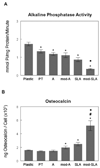Requirement for both micron- and submicron scale structure for synergistic responses of osteoblasts to substrate surface energy and topography
- PMID: 17368532
- PMCID: PMC2754822
- DOI: 10.1016/j.biomaterials.2007.02.024
Requirement for both micron- and submicron scale structure for synergistic responses of osteoblasts to substrate surface energy and topography
Abstract
Objective: Surface roughness and surface free energy are two important factors that regulate cell responses to biomaterials. Previous studies established that titanium (Ti) substrates with micron-scale and submicron scale topographies promote osteoblast differentiation and osteogenic local factor production and that there is a synergistic response to micro-rough Ti surfaces that have retained their high surface energy via processing that limits hydrocarbon contamination. This study tested the hypothesis that the synergistic response of osteoblasts to these modified surfaces depends on both surface micro-structure and surface energy.
Methods: Ti disks were manufactured to present three different surface structures: smooth pretreatment (PT) surfaces with R(a) of 0.2 microm; acid-etched surfaces (A) with a submicron roughness R(a) of 0.83 microm; and sandblasted/acid-etched surfaces (SLA) with R(a) of 3-4 microm. Modified acid-etched (modA) and modified sandblasted/acid-etched (modSLA) Ti substrates, which have low contamination and present a hydroxylated/hydrated surface layer to retain high surface energy, were compared with regular low surface energy A and SLA surfaces. Human osteoblast-like MG63 cells were cultured on these substrates and their responses, including cell shape, growth, differentiation (alkaline phosphatase, osteocalcin), and local factor production (TGF-beta1, PGE(2), osteoprotegerin (OPG)) were analyzed (N=6 per variable). Data were normalized to cell number.
Results: There were no significant differences between smooth PT and A surfaces except for a small increase in OPG. Compared to A surfaces, MG63 cells produced 30% more osteocalcin on modA, and 70% more on SLA. However, growth on modSLA increased osteocalcin by more than 250%, which exceeded the sum of independent effects of surface energy and topography. Similar effects were noted when levels of latent TGF-beta1, PGE(2) and OPG were measured in the conditioned media.
Conclusions: The results demonstrate a synergistic effect between high surface energy and topography of Ti substrates and show that both micron-scale and submicron scale structural features are necessary.
Figures





Similar articles
-
Both cyclooxygenase-1 and cyclooxygenase-2 mediate osteoblast response to titanium surface roughness.J Biomed Mater Res. 2001 Jun 5;55(3):350-9. doi: 10.1002/1097-4636(20010605)55:3<350::aid-jbm1023>3.0.co;2-m. J Biomed Mater Res. 2001. PMID: 11255188
-
Integrin alpha2beta1 plays a critical role in osteoblast response to micron-scale surface structure and surface energy of titanium substrates.Proc Natl Acad Sci U S A. 2008 Oct 14;105(41):15767-72. doi: 10.1073/pnas.0805420105. Epub 2008 Oct 8. Proc Natl Acad Sci U S A. 2008. PMID: 18843104 Free PMC article.
-
Response of normal female human osteoblasts (NHOst) to 17beta-estradiol is modulated by implant surface morphology.J Biomed Mater Res. 2002 Nov;62(2):204-13. doi: 10.1002/jbm.10290. J Biomed Mater Res. 2002. PMID: 12209940
-
Mechanisms regulating increased production of osteoprotegerin by osteoblasts cultured on microstructured titanium surfaces.Biomaterials. 2009 Jul;30(20):3390-6. doi: 10.1016/j.biomaterials.2009.03.047. Epub 2009 Apr 23. Biomaterials. 2009. PMID: 19395022 Free PMC article.
-
Influence of substratum surface chemistry/energy and topography on the human fetal osteoblastic cell line hFOB 1.19: Phenotypic and genotypic responses observed in vitro.Biomaterials. 2007 Nov;28(31):4535-50. doi: 10.1016/j.biomaterials.2007.06.016. Epub 2007 Jul 20. Biomaterials. 2007. PMID: 17644175 Free PMC article. Review.
Cited by
-
Radiographic bone level around particular laser-treated dental implants: 1 to 6 years multicenter retrospective study.Int J Implant Dent. 2020 Jul 28;6(1):29. doi: 10.1186/s40729-020-00230-w. Int J Implant Dent. 2020. PMID: 32719900 Free PMC article.
-
Beyond microroughness: novel approaches to navigate osteoblast activity on implant surfaces.Int J Implant Dent. 2024 Jul 5;10(1):35. doi: 10.1186/s40729-024-00554-x. Int J Implant Dent. 2024. PMID: 38967690 Free PMC article. Review.
-
Integrated analysis of lncRNA-mRNA networks associated with an SLA titanium surface reveals the potential role of HIF1A-AS1 in bone remodeling.RSC Adv. 2020 Jun 2;10(35):20972-20990. doi: 10.1039/d0ra01242d. eCollection 2020 May 27. RSC Adv. 2020. PMID: 35517763 Free PMC article.
-
Electrochemical, Tribological and Biocompatible Performance of Electron Beam Modified and Coated Ti6Al4V Alloy.Int J Mol Sci. 2021 Jun 14;22(12):6369. doi: 10.3390/ijms22126369. Int J Mol Sci. 2021. PMID: 34198700 Free PMC article.
-
Heat and radiofrequency plasma glow discharge pretreatment of a titanium alloy promote bone formation and osseointegration.J Cell Biochem. 2013 Oct;114(10):2363-74. doi: 10.1002/jcb.24585. J Cell Biochem. 2013. PMID: 23649564 Free PMC article.
References
-
- Boyan BD, Lossdorfer S, Wang L, Zhao G, Lohmann CH, Cochran DL, Schwartz Z. Osteoblasts generate an osteogenic microenvironment when grown on surfaces with rough microtopographies. Eur Cell Mater. 2003;6:22–27. - PubMed
-
- Pohler OE. Unalloyed titanium for implants in bone surgery. Injury. 2000;31 Suppl 4:7–13. - PubMed
-
- Cooper LF. A role for surface topography in creating and maintaining bone at titanium endosseous implants. J Prosthet Dent. 2000;84:522–534. - PubMed
-
- Puleo DA, Nanci A. Understanding and controlling the bone-implant interface. Biomaterials. 1999;20:2311–2321. - PubMed
-
- Francois P, Vaudaux P, Taborelli M, Tonetti M, Lew DP, Descouts P. Influence of surface treatments developed for oral implants on the physical and biological properties of titanium. (II) Adsorption isotherms and biological activity of immobilized fibronectin. Clin Oral Implants Res. 1997;8:217–225. - PubMed
Publication types
MeSH terms
Substances
Grants and funding
LinkOut - more resources
Full Text Sources
Miscellaneous

